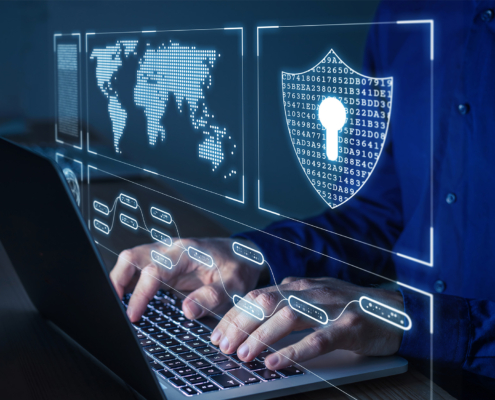 https://medlininc.com/wp-content/uploads/2024/11/it-support-in-data-center.jpg
1250
2000
AbstraktMarketing
/wp-content/uploads/2022/07/146-dbca58e9bf96d055f52912529ed0a163_REV1_LOGO_Medlin-300x78.png
AbstraktMarketing2024-11-01 11:10:572024-11-01 11:11:01The Competitive Advantage of Proactive IT Support from a Managed Service Provider
https://medlininc.com/wp-content/uploads/2024/11/it-support-in-data-center.jpg
1250
2000
AbstraktMarketing
/wp-content/uploads/2022/07/146-dbca58e9bf96d055f52912529ed0a163_REV1_LOGO_Medlin-300x78.png
AbstraktMarketing2024-11-01 11:10:572024-11-01 11:11:01The Competitive Advantage of Proactive IT Support from a Managed Service ProviderEnhancing Cybersecurity: Ransomware Prevention and Detection
With cyberthreats constantly evolving and becoming more sophisticated, individuals and organizations must take proactive measures to enhance their cybersecurity, specifically focusing on ransomware prevention and detection.
The Basics of Ransomware
Ransomware is a kind of malicious software that threatens to publish the victim’s data or perpetually block access to it unless a ransom is paid. It’s become one of the biggest nightmares for cybersecurity professionals. Ransomware can access a system in various ways, though most commonly through a phishing email.
Ransomware is not just about financial loss; it severely affects data confidentiality, integrity, and availability. Once ransomware enters your system, it can encrypt files, making them inaccessible, and demand payment for decryption keys. The proliferation of ransomware attacks underscores the critical need for robust security measures.
Common Types of Ransomware
- Crypto Ransomware: Encrypts valuable files on a computer so the user cannot access them.
- Locker Ransomware: Locks the user out of their operating system, making it impossible to access their desktop, files, and any applications.
- Scareware: Poses as a legitimate cybersecurity software or tool that claims to have found issues on the computer and demands money to fix them.
Each ransomware variant carries its unique threats and challenges. For instance, crypto-ransomware focuses on obtaining monetary gain by encrypting files and demanding a ransom note for the decryption key, further highlighting the critical need for prevention strategies.
The Damaging Effects of Ransomware Attacks
Ransomware attacks can have devastating impacts on both individuals and organizations. These effects range from the loss of critical data to financial losses incurred from paying the ransom and the cost of mitigating the attack. Furthermore, they can damage an organization’s reputation, erode customer trust, and lead to potential legal ramifications of data breach laws.
One of the most underappreciated consequences is the operational downtime it causes. Some organizations might take weeks or even months to recover fully, disrupting services and causing a significant loss in revenue. Indeed, the ripple effects of ransomware attacks highlight the importance of preventive measures.
Ransomware Prevention Tips
Preventing ransomware attacks starts with understanding the tactics used by threat actors. From phishing emails to exploiting vulnerabilities in facing applications, these actors are constantly evolving their methods. Therefore, adopting a multi-layered approach to ransomware prevention is paramount.
Critical components of a comprehensive cybersecurity strategy include regular software updates, employee education, and backup strategies. Each element creates a robust defensive structure against ransomware and other malicious activity.
Implement Strong Cybersecurity Measures
Strong cybersecurity measures are the first line of defense against ransomware attacks. This entails leveraging advanced email security, employing ad blockers, and deploying browser security solutions. Moreover, incorporating network monitoring can help detect malicious activity early.
Organizations must also strive to maintain high-security ratings through regular security tests. This proactive stance ensures that vulnerabilities are patched before ransomware actors exploit them, significantly reducing the risk of an attack.
Importance of Regular Software and System Updates
Outdated software is a crucial vulnerability exploited by malicious actors to access systems. Regular updates patch these vulnerabilities, making it harder for attackers to infiltrate the system. Keeping your operating system, antivirus software, backup software, and all other software up to date is crucial in preventing ransomware infection.
Many cyberattacks, including ransomware, exploit the time gap between discovering a vulnerability and its patch application. Automating software updates can reduce this risk, ensuring systems are promptly protected against known threats.
Effectiveness of Firewalls and Security Software
Firewalls, whether integrated Windows Firewall or third-party applications, act as a barrier between your computer and the internet, filtering out unauthorized access and suspicious traffic. Similarly, respected security software can detect and quarantine ransomware variants before they cause harm.
Utilizing these tools effectively creates a vital defense mechanism, offering unparalleled prevention against ransomware attacks. Alongside this, Browser security solutions can specifically safeguard your web browser from malicious websites and downloads, a common attack vector for ransomware.
Educating Employees about Cybersecurity Risks
Human error, such as falling for a phishing email or failing to recognize malicious social engineering tactics, contributes significantly to the success of ransomware attacks. A comprehensive cybersecurity training program can substantially mitigate these risks by enhancing employee security awareness.
Regular user training sessions should include the following:
- Identifying potential phishing attempts.
- Understanding the importance of strong passwords.
- Recognizing unauthorized attempts to gain access.
By focusing on training, organizations can transform their employees from the weakest link into a robust line of defense against ransomware.
Developing a Comprehensive Backup Strategy
Incident response plans are crucial in the unfortunate event of a ransomware attack. Ensuring that all essential data is backed up in a secure, offline backup infrastructure can immensely reduce the damage caused by ransomware. It empowers organizations to restore data with minimal loss and downtime.
Offline backups are critical since ransomware can also attack network-based backups. Separating from the leading network is essential for protecting backups from being encrypted alongside the primary data.
Importance of Regular Data Backups
Regular backups ensure that the most recent data can be restored in the case of data loss due to a ransomware attack. This practice is essential for maintaining business continuity. The frequency of backups should align with the importance of the data; more critical data may require daily or even hourly backups.
Moreover, the 3-2-1 backup rule—keeping three copies of data on two different media, with one being off site—offers a robust strategy against data loss. By adhering to this rule, organizations can ensure they’re well-prepared to handle a ransomware attack with minimal disruption to their operations.
When preventing any kind of cyber attack, it is critical to check in with your network health periodically. Regular network assessments are an excellent way to keep your business running smoothly.
Ransomware Detection and Response
Identifying a ransomware attack promptly is crucial in mitigating its impact. Once a ransomware infection occurs, it encrypts files, making them inaccessible. Spotting these attacks early can significantly reduce the damage they cause.
Identifying Symptoms of a Ransomware Attack
Recognizing a ransomware attack in its early stages is possible if you know what signs to look for. Awareness and vigilance are vital in catching these malicious activities before they escalate.
Common Signs of a Ransomware Infection
- Unexpected files or programs that automatically start up
- Slow computer performance or frequent crashes
- Files become inaccessible, or file extensions change
- A ransom note appears demanding payment
Noticing these signs necessitates urgent action to prevent further damage. Recognizing these indicators is a testament to the importance of regular user training and security awareness.
Steps to Take After a Ransomware Attack
The moments following the detection of a ransomware attack are critical. The first step is disconnecting infected devices from all networks to prevent the spread of the ransomware. Next, it’s essential to assess the impact’s scope and secure unaffected devices and data.
Creating a detailed record of the ransomware attack, including the ransom note, is essential for the subsequent investigation and reporting of the incident to the authorities. Contacting a cybersecurity expert to help resolve the issue is highly recommended.
Isolation and Investigation
Immediately isolating affected systems helps contain the ransomware and prevents it from spreading to other devices. During the isolation phase, an in-depth investigation must be carried out to understand how the ransomware gained access, which can be crucial in preventing future attacks.
Experience Complete Ransomware Prevention With Medlin Communication’s Cybersecurity Services
In today’s world, every business needs quality cybersecurity. With Medlin, worries and stress about cyber attacks can become a thing of the past. Our team is ready to help your business take care of these threats and more with our managed services and consulting. Contact us today and get started with a conversation about your IT.
Share This Post
More Like This
 https://medlininc.com/wp-content/uploads/2024/11/it-support-in-data-center.jpg
1250
2000
AbstraktMarketing
/wp-content/uploads/2022/07/146-dbca58e9bf96d055f52912529ed0a163_REV1_LOGO_Medlin-300x78.png
AbstraktMarketing2024-11-01 11:10:572024-11-01 11:11:01The Competitive Advantage of Proactive IT Support from a Managed Service Provider
https://medlininc.com/wp-content/uploads/2024/11/it-support-in-data-center.jpg
1250
2000
AbstraktMarketing
/wp-content/uploads/2022/07/146-dbca58e9bf96d055f52912529ed0a163_REV1_LOGO_Medlin-300x78.png
AbstraktMarketing2024-11-01 11:10:572024-11-01 11:11:01The Competitive Advantage of Proactive IT Support from a Managed Service Provider
What Are Managed IT Services? Your Guide to an Essential Technology Solution
Managed IT
Exploring the Benefits of Managed IT Services
Managed IT
Essential Cybersecurity Best Practices to Protect Your Business and Your Clients
Cybersecurity
Managed IT Services and Remote Work Development
Managed IT
How Managed IT Services Facilitate Business Growth for Small Enterprises
Managed IT
Unlock Business Growth with Managed Service Providers: Your Path to Success
Managed IT
Understanding Cyber Attacks: A Deep Dive into the Costs Beyond the Surface
Cybersecurity
